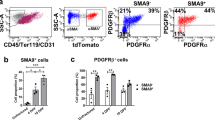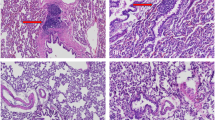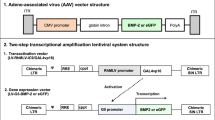Abstract
Efficacious bone regeneration could revolutionize the clinical management of bone and musculoskeletal disorders. Although several bone morphogenetic proteins (BMPs) (mostly BMP-2 and BMP-7) have been shown to induce bone formation, it is unclear whether the currently used BMPs represent the most osteogenic ones. Until recently, comprehensive analysis of osteogenic activity of all BMPs has been hampered by the fact that recombinant proteins are either not biologically active or not available for all BMPs. In this study, we used recombinant adenoviruses expressing the 14 types of BMPs (AdBMPs), and demonstrated that, in addition to currently used BMP-2 and BMP-7, BMP-6 and BMP-9 effectively induced orthotopic ossification when either AdBMP-transduced osteoblast progenitors or the viral vectors were injected into the quadriceps of athymic mice. Radiographic and histological evaluation demonstrated that BMP-6 and BMP-9 induced the most robust and mature ossification at multiple time points. BMP-3, a negative regulator of bone formation, was shown to effectively inhibit orthotopic ossification induced by BMP-2, BMP-6, and BMP-7. However, BMP-3 exerted no inhibitory effect on BMP-9-induced bone formation, suggesting that BMP-9 may transduce osteogenic signaling differently. Our findings suggest that BMP-6 and BMP-9 may represent more effective osteogenic factors for bone regeneration.
This is a preview of subscription content, access via your institution
Access options
Subscribe to this journal
Receive 12 print issues and online access
$259.00 per year
only $21.58 per issue
Buy this article
- Purchase on Springer Link
- Instant access to full article PDF
Prices may be subject to local taxes which are calculated during checkout





Similar content being viewed by others
References
DeWitt N . Bone and cartilage. Nature 2003; 423: 315.
Olsen BR, Reginato AM, Wang W . Bone development. Annu Rev Cell Dev Biol 2000; 16: 191–220.
Reddi AH . Role of morphogenetic proteins in skeletal tissue engineering and regeneration. Nat Biotechnol 1998; 16: 247–252.
Urist MR . Bone: formation by autoinduction. Science 1965; 150: 893–899.
Wozney JM et al. Novel regulators of bone formation: molecular clones and activities. Science 1988; 242: 1528–1534.
Hogan BL . Bone morphogenetic proteins: multifunctional regulators of vertebrate development. Genes Dev 1996; 10: 1580–1594.
Zou H et al. BMP signaling and vertebrate limb development. Cold Spring Harb Symp Quant Biol 1997; 62: 269–272.
Massague J, Weis-Garcia F . Serine/threonine kinase receptors: mediators of transforming growth factor beta family signals. Cancer Surv 1996; 27: 41–64.
Yamashita H, Ten Dijke P, Heldin CH, Miyazono K . Bone morphogenetic protein receptors. Bone 1996; 19: 569–574.
Heldin CH, Miyazono K, ten Dijke P . TGF-beta signalling from cell membrane to nucleus through SMAD proteins. Nature 1997; 390: 465–471.
Massague J . TGF-beta signal transduction. Annu Rev Biochem 1998; 67: 753–791.
Wrana JL . Regulation of Smad activity. Cell 2000; 100: 189–192.
Heckman JD, Boyan BD, Aufdemorte TB, Abbott JT . The use of bone morphogenetic protein in the treatment of non-union in a canine model. J Bone Joint Surg Am 1991; 73: 750–764.
Gerhart TN et al. Healing segmental femoral defects in sheep using recombinant human bone morphogenetic protein. Clin Orthop 1993; 349: 317–326.
Lee SC et al. Healing of large segmental defects in rat femurs is aided by RhBMP-2 in PLGA matrix. J Biomed Mater Res 1994; 28: 1149–1156.
Bostrom MP, Camacho NP . Potential role of bone morphogenetic proteins in fracture healing. Clin Orthop 1998; 355 (Suppl): S274–S282.
Cheng SL et al. In vitro and in vivo induction of bone formation using a recombinant adenoviral vector carrying the human BMP-2 gene. Calcif Tissue Int 2001; 68: 87–94.
Krebsbach PH, Gu K, Franceschi RT, Rutherford RB . Gene therapy-directed osteogenesis: BMP-7-transduced human fibroblasts form bone in vivo (in process citation). Hum Gene Ther 2000; 11: 1201–1210.
Partridge K et al. Adenoviral BMP-2 gene transfer in mesenchymal stem cells: in vitro and in vivo bone formation on biodegradable polymer scaffolds. Biochem Biophys Res Commun 2002; 292: 144–152.
Riew KD et al. Induction of bone formation using a recombinant adenoviral vector carrying the human BMP-2 gene in a rabbit spinal fusion model. Calcif Tissue Int 1998; 63: 357–360.
Varady P et al. Morphologic analysis of BMP-9 gene therapy-induced osteogenesis. Hum Gene Ther 2001; 12: 697–710.
Varady P et al. CT and radionuclide study of BMP-2 gene therapy-induced bone formation. Acad Radiol 2002; 9: 632–637.
Helm GA et al. Use of bone morphogenetic protein-9 gene therapy to induce spinal arthrodesis in the rodent. J Neurosurg 2000; 92: 191–196.
Sandhu HS, Khan SN, Suh DY, Boden SD . Demineralized bone matrix, bone morphogenetic proteins, and animal models of spine fusion: an overview. Eur Spine J 2001; 10 (Suppl. 2): S122–S131.
Boden SD, Zdeblick TA, Sandhu HS, Heim SE . The use of rhBMP-2 in interbody fusion cages. Definitive evidence of osteoinduction in humans: a preliminary report. Spine 2000; 25: 376–381.
Friedlaender GE . OP-1 clinical studies. J Bone Joint Surg Am 2001; 83-A: S160–S161.
Valentin-Opran A et al. Clinical evaluation of recombinant human bone morphogenetic protein-2. Clin Orthop 2002; 395: 110–120.
Whang K et al. Ectopic bone formation via rhBMP-2 delivery from porous bioabsorbable polymer scaffolds. J Biomed Mater Res 1998; 42: 491–499.
Alden TD et al. Percutaneous spinal fusion using bone morphogenetic protein-2 gene therapy. J Neurosurg 1999; 90: 109–114.
Oyama M et al. Retrovirally transduced bone marrow stromal cells isolated from a mouse model of human osteogenesis imperfecta (oim) persist in bone and retain the ability to form cartilage and bone after extended passaging. Gene Therapy 1999; 6: 321–329.
Alden TD et al. In vivo endochondral bone formation using a bone morphogenetic protein 2 adenoviral vector. Hum Gene Ther 1999; 10: 2245–2253.
Baltzer AW et al. Genetic enhancement of fracture repair: healing of an experimental segmental defect by adenoviral transfer of the BMP-2 gene. Gene Therapy 2000; 7: 734–739.
Baltzer AW et al. Potential role of direct adenoviral gene transfer in enhancing fracture repair. Clin Orthop 2000; 379 (Suppl): S120–S125.
Bosch P et al. The efficiency of muscle-derived cell-mediated bone formation. Cell Transplant 2000; 9: 463–470.
Breitbart AS et al. Gene-enhanced tissue engineering: applications for bone healing using cultured periosteal cells transduced retrovirally with the BMP-7 gene. Ann Plast Surg 1999; 42: 488–495.
Franceschi RT, Wang D, Krebsbach PH, Rutherford RB . Gene therapy for bone formation: in vitro and in vivo osteogenic activity of an adenovirus expressing BMP7. J Cell Biochem 2000; 78: 476–486.
Gazit D et al. Engineered pluripotent mesenchymal cells integrate and differentiate in regenerating bone: a novel cell-mediated gene therapy. J Gene Med 1999; 1: 121–133.
Lieberman JR et al. Regional gene therapy with a BMP-2-producing murine stromal cell line induces heterotopic and orthotopic bone formation in rodents. J Orthop Res 1998; 16: 330–339.
Lou J, Xu F, Merkel K, Manske P . Gene therapy: adenovirus-mediated human bone morphogenetic protein-2 gene transfer induces mesenchymal progenitor cell proliferation and differentiation in vitro and bone formation in vivo. J Orthop Res 1999; 17: 43–50.
Mason JM et al. Expression of human bone morphogenic protein 7 in primary rabbit periosteal cells: potential utility in gene therapy for osteochondral repair. Gene Therapy 1998; 5: 1098–1104.
Musgrave DS et al. Adenovirus-mediated direct gene therapy with bone morphogenetic protein-2 produces bone. Bone 1999; 24: 541–547.
Okubo Y et al. Osteoinduction by bone morphogenetic protein-2 via adenoviral vector under transient immunosuppression. Biochem Biophys Res Commun 2000; 267: 382–387.
Ripamonti U et al. Bone induction by BMPs/OPs and related family members in primates. J Bone Joint Surg Am 2001; 83-A: S116–S127.
Lee JY et al. Effect of bone morphogenetic protein-2-expressing muscle-derived cells on healing of critical-sized bone defects in mice. J Bone Joint Surg Am 2001; 83-A: 1032–1039.
Cheng H et al. Osteogenic activity of the 14 types of human bone morphogenetic proteins (BMPs). J Bone Joint Surgery Am 2003; 85-A: 1544–1552.
Robbins PD, Tahara H, Ghivizzani SC . Viral vectors for gene therapy. Trends Biotechnol 1998; 16: 35–40.
Kay MA, Glorioso JC, Naldini L . Viral vectors for gene therapy: the art of turning infectious agents into vehicles of therapeutics. Nat Med 2001; 7: 33–40.
Alemany R, Balague C, Curiel DT . Replicative adenoviruses for cancer therapy. Nat Biotechnol 2000; 18: 723–727.
Breyer B et al. Adenoviral vector-mediated gene transfer for human gene therapy. Curr Gene Ther 2001; 1: 149–162.
Thomas CE, Ehrhardt A, Kay MA . Progress and problems with the use of viral vectors for gene therapy. Nat Rev Genet 2003; 4: 346–358.
Sun MH et al. Bone morphogenetic proteins and bone regeneration: from biology to clinical applications. Adv Osteoporotic Fract Manag 2003; 2: 70–78.
Bahamonde ME, Lyons KM . BMP3: to be or not to be a BMP. J Bone Joint Surg Am 2001; 83-A: S56–S62.
Lee JY et al. Enhancement of bone healing based on ex vivo gene therapy using human muscle-derived cells expressing bone morphogenetic protein 2. Hum Gene Ther 2002; 13: 1201–1211.
Lieberman JR, Daluiski A, Einhorn TA . The role of growth factors in the repair of bone. Biology and clinical applications. J Bone Joint Surg Am 2002; 84-A: 1032–1044.
Noda M, Camilliere JJ . In vivo stimulation of bone formation by transforming growth factor-beta. Endocrinology 1989; 124: 2991–2994.
Joyce ME, Terek RM, Jingushi S, Bolander ME . Role of transforming growth factor-beta in fracture repair. Ann N Y Acad Sci 1990; 593: 107–123.
Lind M et al. Transforming growth factor-beta enhances fracture healing in rabbit tibiae. Acta Orthop Scand 1993; 64: 553–556.
Nielsen HM, Andreassen TT, Ledet T, Oxlund H . Local injection of TGF-beta increases the strength of tibial fractures in the rat. Acta Orthop Scand 1994; 65: 37–41.
Critchlow MA, Bland YS, Ashhurst DE . The effect of exogenous transforming growth factor-beta 2 on healing fractures in the rabbit. Bone 1995; 16: 521–527.
Sumner DR et al. Enhancement of bone ingrowth by transforming growth factor-beta. J Bone Joint Surg Am 1995; 77: 1135–1147.
Canalis E, Centrella M, McCarthy T . Effects of basic fibroblast growth factor on bone formation in vitro. J Clin Invest 1988; 81: 1572–1577.
Kato T et al. Single local injection of recombinant fibroblast growth factor-2 stimulates healing of segmental bone defects in rabbits. J Orthop Res 1998; 16: 654–659.
Nakamura T et al. Recombinant human basic fibroblast growth factor accelerates fracture healing by enhancing callus remodeling in experimental dog tibial fracture. J Bone Miner Res 1998; 13: 942–949.
Radomsky ML, Thompson AY, Spiro RC, Poser JW . Potential role of fibroblast growth factor in enhancement of fracture healing. Clin Orthop 1998; 355 (Suppl): S283–S293.
Radomsky ML et al. Novel formulation of fibroblast growth factor-2 in a hyaluronan gel accelerates fracture healing in nonhuman primates. J Orthop Res 1999; 17: 607–614.
Nash TJ et al. Effect of platelet-derived growth factor on tibial osteotomies in rabbits. Bone 1994; 15: 203–208.
Thaller SR, Dart A, Tesluk H . The effects of insulin-like growth factor-1 on critical-size calvarial defects in Sprague–Dawley rats. Ann Plast Surg 1993; 31: 429–433.
Trippel SB . Potential role of insulinlike growth factors in fracture healing. Clin Orthop 1998; 355 (Suppl): S301–S313.
Boden SD et al. Lumbar spine fusion by local gene therapy with a cDNA encoding a novel osteoinductive protein (LMP-1). Spine 1998; 23: 2486–2492.
Linkhart TA, Mohan S, Baylink DJ . Growth factors for bone growth and repair: IGF, TGF beta and BMP. Bone 1996; 19: 1S–12S.
Azari K et al. Therapeutic potential of bone morphogenetic proteins. Expert Opin Investig Drugs 2001; 10: 1677–1686.
Alden TD et al. Bone morphogenetic protein gene therapy. Spine 2002; 27: S87–S93.
Yoon ST, Boden SD . Osteoinductive molecules in orthopaedics: basic science and preclinical studies. Clin Orthop 2002; 395: 33–43.
Solloway MJ et al. Mice lacking Bmp6 function. Dev Genet 1998; 22: 321–339.
Jane J et al. Ectopic osteogenesis using adenoviral bone morphogenetic protein (BMP)-4 and BMP-6 gene transfer. Mol Ther 2002; 6: 464.
Song JJ et al. Bone morphogenetic protein-9 binds to liver cells and stimulates proliferation. Endocrinology 1995; 136: 4293–4297.
Ploemacher RE et al. Bone morphogenetic protein 9 is a potent synergistic factor for murine hemopoietic progenitor cell generation and colony formation in serum-free cultures. Leukemia 1999; 13: 428–437.
Lopez-Coviella I et al. Induction and maintenance of the neuronal cholinergic phenotype in the central nervous system by BMP-9. Science 2000; 289: 313–316.
Dumont RJ et al. Ex vivo bone morphogenetic protein-9 gene therapy using human mesenchymal stem cells induces spinal fusion in rodents. Neurosurgery 2002; 51: 1239–1245.
Peng Y et al. Transcriptional characterization of bone morphogenetic proteins (BMPs)-mediated osteogenic signaling. J Cell Biochem 2003; 90: 1149–1165.
He TC et al. A simplified system for generating recombinant adenoviruses. Proc Natl Acad Sci USA 1998; 95: 2509–2514.
Acknowledgements
We thank Dr Mark Bolander of Mayo Clinic for valuable discussion and critical review of the manuscript. We thank the Genetics Institute of Cambridge, MA, for providing human BMP cDNAs. We apologize to the researchers whose original work was not cited due to space constraints. The work was supported in part by research grants from the Aircast Foundation, the Brinson Foundation, North American Spine Society, and the Orthopaedic Research and Education Foundation. Q Kang was a recipient of an International Postdoctoral Fellowship from the National Institutes of Health (F05 AT002014-01).
Author information
Authors and Affiliations
Rights and permissions
About this article
Cite this article
Kang, Q., Sun, M., Cheng, H. et al. Characterization of the distinct orthotopic bone-forming activity of 14 BMPs using recombinant adenovirus-mediated gene delivery. Gene Ther 11, 1312–1320 (2004). https://doi.org/10.1038/sj.gt.3302298
Received:
Accepted:
Published:
Issue Date:
DOI: https://doi.org/10.1038/sj.gt.3302298
Keywords
This article is cited by
-
Stem cell sources from human biological waste material: a role for the umbilical cord and dental pulp stem cells for regenerative medicine
Human Cell (2023)
-
Efficient bone regeneration of BMP9-stimulated human periodontal ligament stem cells (hPDLSCs) in decellularized bone matrix (DBM) constructs to model maxillofacial intrabony defect repair
Stem Cell Research & Therapy (2022)
-
iPSC-neural crest derived cells embedded in 3D printable bio-ink promote cranial bone defect repair
Scientific Reports (2022)
-
TAZ promotes osteogenic differentiation of mesenchymal stem cells line C3H10T1/2, murine multi-lineage cells lines C2C12, and MEFs induced by BMP9
Cell Death Discovery (2022)
-
Identification of key genes and pathways of BMP-9-induced osteogenic differentiation of mesenchymal stem cells by integrated bioinformatics analysis
Journal of Orthopaedic Surgery and Research (2021)



